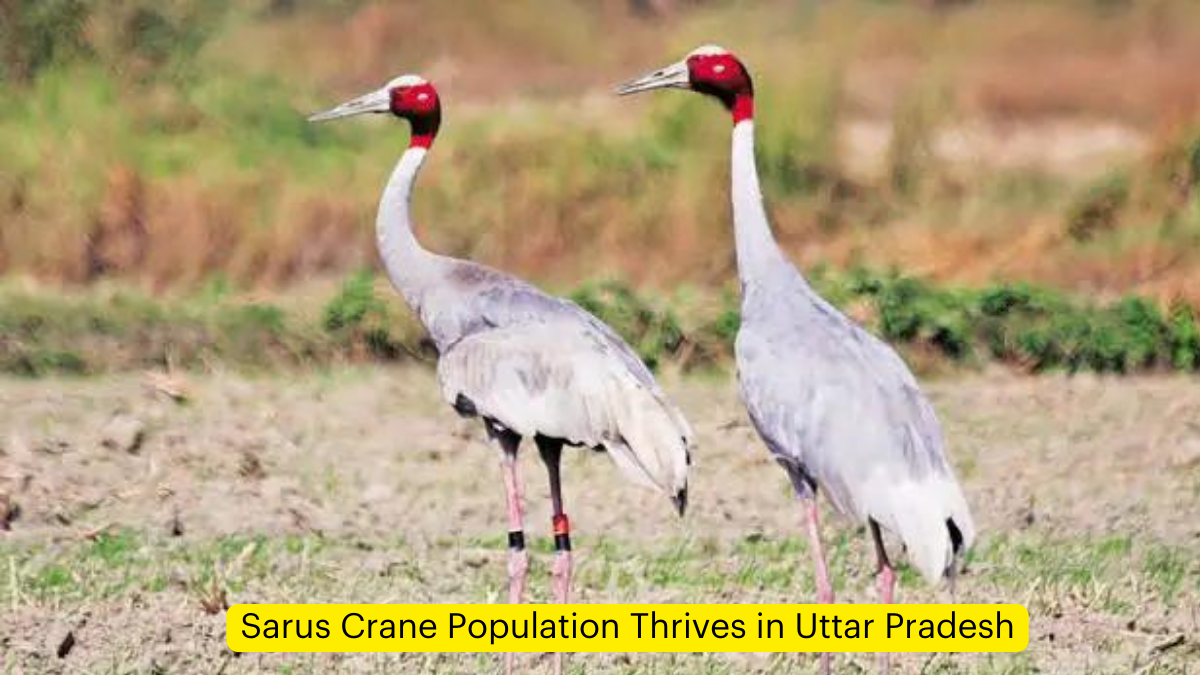The Forest Department of Uttar Pradesh has released its latest summer census figures for the state bird, the Sarus Crane. The report, unveiled on July 10, 2024, reveals a promising trend in the conservation efforts of this majestic species.
Census Highlights
Population Increase
The total population of Sarus Cranes in Uttar Pradesh has reached 19,918, marking an increase of 396 individuals compared to the previous year. This growth underscores the success of ongoing conservation efforts in the state.
Methodology
The summer census was conducted by the Forest Department with the assistance of 10,000 citizens, demonstrating a collaborative approach to wildlife monitoring. It’s important to note that the census focuses on forest areas and does not include private lands where these birds are also known to inhabit.
Uttar Pradesh’s Significance
Uttar Pradesh maintains its position as the state with the largest Sarus Crane population in India, reinforcing its crucial role in the species’ conservation.
Historical Trend Analysis
Consistent Growth
The Sarus Crane population in Uttar Pradesh has shown a steady increase over recent years:
- 2021: 17,329 cranes
- 2022: 19,188 cranes
- 2023: 19,522 cranes
- 2024: 19,918 cranes
This consistent upward trend indicates the effectiveness of conservation measures implemented in the state.
Notable Discovery
For the first time in a decade, the Mau forest division reported a sighting of six Sarus Cranes, suggesting a potential expansion of the species’ range within the state.
Geographical Distribution
Top Regions
The census report highlights the forest divisions with the highest Sarus Crane populations:
- Etawah Forest Division: 3,289 cranes
- Mainpuri: 2,945 cranes
- Shahjahanpur: 1,212 cranes
- Auraiya: 1,202 cranes
- Kannauj: 786 cranes
Other notable divisions include Hardoi (735), Sant Kabir Nagar (717), Kanpur Dehat (709), Gorakhpur (675), and Siddharth Nagar (673).
Moderate Population Areas
Twenty-seven forest divisions reported between 100 to 500 birds. Some notable examples include:
- Raebareli: 428 cranes
- Sitapur: 427 cranes
- Unnao: 426 cranes
- Bareilly: 348 cranes
- Sohagi Barwa: 339 cranes
Low Population Areas
Thirty-one forest divisions recorded fewer than 100 cranes, indicating areas where conservation efforts might need to be intensified.
About the Sarus Crane
State Recognition
The Sarus Crane was declared the state bird of Uttar Pradesh in 2014, highlighting its cultural and ecological significance to the region.
Physical Characteristics
Known as the world’s tallest flying bird, the Sarus Crane is an impressive species that captures the imagination of both researchers and nature enthusiasts.
Habitat Preference
Sarus Cranes primarily nest in wetland areas, emphasizing the importance of preserving these ecosystems for the species’ continued survival.
Legal Protection
The Sarus Crane is included in Schedule IV of the Wildlife (Protection) Act, 1972, providing it with legal protection and underscoring its conservation importance.
Important takeaways for all competitive exams
- UP Capital: Lucknow (Executive Branch);
- UP Districts: 75 (18 divisions);
- UP Flower: Palash;
- UP Formation: 24 January 1950.




 Tamil Nadu Launches India’s First Deepte...
Tamil Nadu Launches India’s First Deepte...
 Uttarakhand Police Ranks First in ICJS 2...
Uttarakhand Police Ranks First in ICJS 2...
 Chhattisgarh Gets Its First Ramsar Site:...
Chhattisgarh Gets Its First Ramsar Site:...







